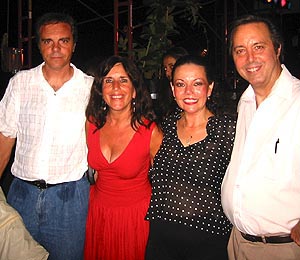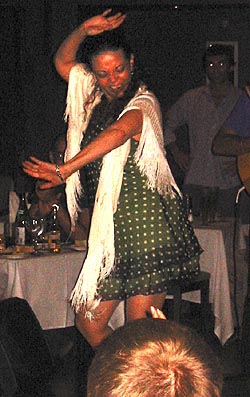
|
|
"You may listen to Jimi, but you can't hear Jimi!" (Friday August 2, 2002) Do you remember that line from the 1992 movie White Men Can't Jump? This is where Wesley Snipe's character explains to Woody Harrelson's character something about Jimi's music. The "Jimi" they are referring to here is the influential rock guitarist Jimi Hendrix. You'll have to see the movie yourself to understand exactly what that line means, but I find it interesting because emphasizes a difference between two words: listen AND hear. According to the Merriam Webster dictionary:
How does this apply to flamenco? The roles can be reversed but for now I'll just explain how dancers should learn to hear guitarists. The guitarist can communicate, through the music, messages such as:
Another kind of hearing deals with the emotional aspects. Usually you know from the beginning whether something is serious or happy or somewhere in between. But music shouldn't be at one emotional level. It should have moments of tension and release. There are many different ways of communicating tension and release. There's a reason why the guitarist plays the music in a certain way. Get beyond just listening. Hear in order to understand. In the beginning stages, flamenco dance students are understandably so busy thinking about technique and sequences of movements that they can only listen to the music. That's just the way most people learn. But at some point, you'll have the opportunity to start to hear the music. When that day comes, you'll know it. Guitarists: all of this applies to you too. The dancer is trying to communicate something to you. The dancer is more than human drum machine. Try to hear to understand.
I know what you're thinking: a good follow-up to this article would be something titled "You may listen to Camarón, but you can't hear Camarón!" No thanks. Discuss that topic amongst yourselves.
In the photo, starting from the left: guitarist Jesús Serrano, dancers Natalia Monteleón and "Lali" Solangel Calix, guitarist Henry Jova. Natalia writes: "About 10 years ago, I was dating a fascinating jazz musician based in New Orleans, (Mr. David Sager), and would travel to N.O. whenever possible. Of course, whenever in a new place I would look for the flamenco people, as I guess most of us do. There was one very good Spanish restaurant in town owned by a sevillano, which had a weekend flamenco show. Whenever I visited it ever happened to be at the right time to see the show, but I got to know the owner slightly, and he found that I worked at el Bodegón (at that time). He asked if I would sub for the regular dancer one Valentine's Day, mentioning that the dancer was his wife, and she had just had twins and wasn't dancing. I was happy to have a double reason to go to N.O., to see David and to do a gig. Innocently I walked into a situation where there were two dancers: the wife, and a teenage girl, the daughter of the guitarist, Carlos Sanchez. Boy did I feel silly! Expecting a chilly reception from the real dancer, I was thrilled to meet Solangel Calix - but to all of us - Lali! She immediately put me at ease, made me feel welcome, adjusted the show to fit three people, etc. We spent the whole night chatting about the scene in our respective cities, and found that we both worked in law firms for our day job. That turned out not to be the only thing we had in common! About 4-5 months later, when I was considering moving to N.O., I was visiting David, and we peeked into the window of a local club to find a handsome guy dancing along with the crowd in the club, but he was doing flamenco moves to salsa music. He was surrounded by an entourage -- one of whom was Lali. I jumped in, made the acquaintance of everyone, found a great teacher (the man was Paco del Puerto) a great group of flamenco dancers and aficionados, and within the next few days became convinced that New Orleans was the place for me. Lali lent me shoes the next day so that I could take Paco's class. She eventually became my first friend in New Orleans, she welcomed me when I moved to the city. We performed together, started a group together, and confided the secrets of our lives to each other. Many a night was spent at either her house, mine or one of our students, for an all-night girls only "juerga" of 5-6 people. We didn't even have a guitarist, we just sang, danced, listened to cds, watched videos, drank wine, cooked, and stayed up 'til the crack of dawn having fun. We all were going through our personal little dramas, and this was our emotional as well as artistic outlet. Those of you who met Lali this weekend, may have gotten a small glimpse of the liveliest, warmest, giving-est, and most down to earth person in the flamenco world. Her personality just sparkles, she has a positive take on life, no matter what has been dished out. Her sense of humor and joy of life leaves me trailing behind trying to catch up. (and that's no mean feat)! Too bad it had to take me 7 years to bring her here! How time does fly. Lali is still the reigning queen of Flamenco in New Orleans, and whenever any of you go down to visit, just stop by el Matador in the 'quarter' and say hi to Lali, John, Michelle and the group. You are sure to have a ball!" [Editor's note: "El Matador" is located at 504 Esplanade Ave in New Orleans. Call (504)569-8361 for more info.] |

 Arte
Flamenco took hold in New Orleans, with Lali's help. Obviously - she
knew the people in town, had the connections, and was able to help me
make it a reality. One particular entrepreneur told me that he was only
hiring my group on Lali's good word - he respected her opinion, and
that's why me - the unknown got "in". Our little group performed at
Arte
Flamenco took hold in New Orleans, with Lali's help. Obviously - she
knew the people in town, had the connections, and was able to help me
make it a reality. One particular entrepreneur told me that he was only
hiring my group on Lali's good word - he respected her opinion, and
that's why me - the unknown got "in". Our little group performed at